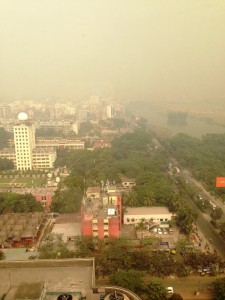
By the fourth day of my one-week trip to Dhaka, the capital city of Bangladesh, I was coughing every few minutes. The soot and chemicals that float through the air of one of the world’s most air quality-compromised cities are inescapable for residents. Smog-producing emissions are one result of the country’s booming brick-manufacturing industry.
A second result is jobs: The industry employs about one million people and contributes more than 1 percent to total GDP. Five thousand kilns in the country — each burning high-sulfur coal, wood and used rubber tires to produce some five billion bricks and six million tons of CO2 per year —ring the city and dot the countryside, churning out the building blocks for the businesses, bridges and byways that support a growing economy and population (see UNDP’s GREEN Brick project).
In November 2015, I was on a mission in Bangladesh to develop a project proposal as part of my Bard CEP internship with the United Nations Development Programme (UNDP). And although smog-forming particulates captured my attention that day at UNDP’s Bangladesh country office, it was not soot or sulfur, but an entirely invisible molecule that had brought me to the country: carbon dioxide.
Climate Change Vulnerability in Bangladesh
Bangladesh is one of the most vulnerable countries in the world to the impacts of climate change, ranking fifth on the World Risk Index of countries most at risk of becoming the victim of a natural disaster. In any given year, up to one-fifth of Bangladesh will be inundated by flood water, particularly affecting the 20 percent of the country’s residents who live in coastal areas. Cyclone Sidr alone exposed 3.5 million households to inundation and cyclone-exposed areas are projected to expand the affected population by as much as 122% by 2050. Simply, climate change makes the lives and livelihoods of Bangladesh’s 155 million people all the more tenuous.
My six-month internship with UNDP as part of the Climate Change Adaptation team in the Bangkok Regional Hub was about finding solutions. The opportunity allowed me to learn a great deal about Bangladesh and many of the region’s other 36 countries and territories with which UNDP works, including climate impacts each suffers and the opportunities for resilience UNDP helps each to realize. (See my previous post that highlights UNDP work in Cambodia.)
Focus on Adaptation
Confirming what I studied during first-year policy classes at Bard CEP, I learned that climate adaptation projects, like most projects, should be country-driven and begin with engaging stakeholders. UNDP interns are fortunate if they have the opportunity to go on a mission to a partner country to develop a project, and good fortune had me meeting with various government partners in Bangladesh to discuss their adaptation priorities.
Talks with the country’s research institutes, various ministries and the largest NGO serving the rural population began optimistically but became more tense when conversation turned to how to finance solutions. Happily, this is an exciting time for climate finance and optimism about the future may be more warranted than ever.
Changing Landscape of Climate Science
Leading up to and following the Paris Agreement, adopted during the 2015 UNFCCC Conference of the Parties (COP 21), climate adaptation is receiving more attention. The hope among Bangladesh and many other states most vulnerable to climate change is that adaptation activities will be targeted for greater funding.
My first UNDP mission ended with good insights and a positive outlook. Upon returning to Bangkok, I got back to work at the activities that formed the bulk of my internship experience: researching, writing and providing general support for various climate fund project proposals.
While Bard CEP’s first-year economics coursework provided me with the foundational knowledge useful for understanding carbon markets and emissions abatement, UNDP gave my the opportunity to engage first-hand with the vast landscape of climate finance: More than 50 international public funds, 60 carbon markets and 6,000 private equity funds already provide some type of “green” finance. Each is unique in the types of projects it wants to pay for, the types of finance it makes available, and the countries it works in. Learning to access these channels is a valuable skill for a career-seeking development intern but it is of grave necessity for the people living in the most climate-impacted regions.
Hopeful Outlook
Going on mission to Bangladesh breathed tangible life into my professors’ words and my UNDP project proposals as theory and study became applied, first-hand engagement with the Bangladesh people’s climate struggle. The mission also renewed the sense of urgency that spurred me to apply to Bard CEP and UNDP in the first place.
Now is the time to clear the air. The resolve I witnessed among Bangladesh’s decision makers, the commitment shown by my UNDP colleagues, the changing landscape of climate finance and the passion of my professors and fellow classmates all give reason to be hopeful the world can adapt to climate change.
For a roundup of climate change adaptation projects either completed or underway in Bangladesh, visit UNDP’s Community-Based Adaption page.

